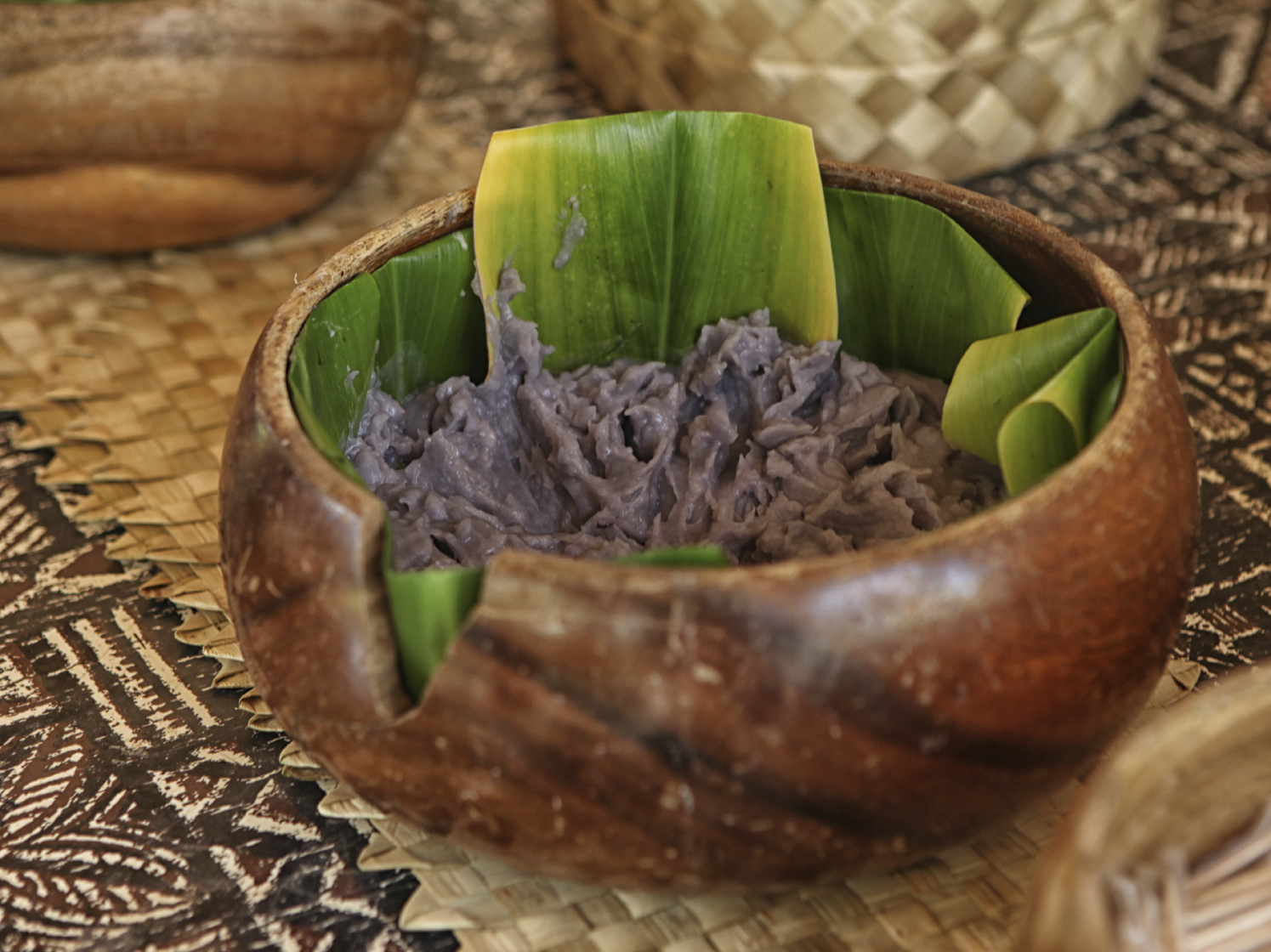 Enlarge image i
Enlarge image i Historians think poi, a sticky, nutritious food made from pounded taro root, has been eaten in the Hawaiian islands since the time of the ancient Polynesians.

Historians think poi, a sticky, nutritious food made from pounded taro root, has been eaten in the Hawaiian islands since the time of the ancient Polynesians.
There are only about 1,000 people of pure Hawaiian descent left in the world, but island residents are cooking up an idea to keep native island culture from fading away. The key ingredient? Reviving a starchy food called poi.
A sticky, nutritious food made from pounded taro root, poi looks similar to bread dough. Very chewy, with a mild and slightly sweet flavor, poi was long a staple of the native Hawaiian diet and held spiritual significance for the island's aboriginals. In fact, historians think poi sustained the first people to land on Hawaiian shores Polynesians who may have traveled thousands of miles by canoe.
To keep that tradition alive in the face of modern diets, poi partisans have turned to places like Kamehameha, the most prestigious high school on the island of Oahu. It's the kind of place where you might expect to find students in blue blazers. But outside one classroom, young men wear "malo," or loin cloths a suitable uniform used when pounding steamed taro roots using stones and wooden boards.
Seventeen-year-old Blaine Hull is meticulous about poi and ku'i, the process used to make it.
"If you have any cuts on your hand, you can't ku'i," he explains. "Girls, they have to have their hair tied back, because you don't want any hair in it. We try to have girls take off any fingernail polish. Rings come off all that kind of stuff. So it's just trying to get down to the bare and just ku'i."
 Enlarge image i
Enlarge image i A youth creates poi via ku'i, a process in which taro roots are crushed by stone.

A youth creates poi via ku'i, a process in which taro roots are crushed by stone.
In a day or two, the poi begins to ferment and develops a sour taste. And like sour dough, it can be stored indefinitely without fear of spoilage.
When students first began attending Kamehameha in 1887, poi was served at every meal. Then, there was a taro shortage in 1920, and the dining hall switched to potatoes heating a huge food fight. The shortage could be traced to sugar barons planting former taro fields.
Today, the sugar cane is gone, but now taro plants must compete for territory with another major industry: housing, says Daniel Anthony, who volunteers at the high school twice a month to show students how to make poi.
"Basically, a taro patch is the best place to plant a house, because it's already flat," Anthony says. "Wherever you see a house, [it] was most likely a taro patch."
And that's why the University of Hawaii's Cooperative Extension Service is teaching people to grow this crop in their own backyards. The location of their 30-acre demonstration plot tucked between a Home Depot and a freeway underscores just how scarce farmland is on the island.
Jayme Grzebik, an urban horticulturist, helps out with the teaching efforts. She walks past rows of green leaves some streaked with red and purple, others as big as elephant ears. They mark the spot where 80 varieties of taro grow.
Grzebik offers workshops on how to plant corms, or mother plants, which look like large, beige beets, and how to collect the baby taro roots called keikis six months later.
"This is a very important crop, culturally," she says. "It's something that brings the family together, like shucking corn, maybe."
And noting that Hawaii imports most of its food, she says, cultivation of taro and production of poi could make life on the islands more sustainable and create jobs.
National Park Service Polynesian Cultural Center Official Site - Best Luau Oahu, Hawaii Official site of Hawaii's 1 paid attraction and activity offers an authentic showcase of 7 Polynesian cultures, Luau, an IMAX theater, and more Kombucha - Wikipedia, the free encyclopedia Kombucha is an effervescent fermentation of sweetened tea that is used as a functional food. Sometimes referred to as a "mushroom" or "mother", the kombucha culture ... Hawaii: Map, History from Answers.com Hawaii or Hawai'i ( Abbr. HI ) A state of the United States in the central Pacific Ocean comprising the Hawaiian Islands Hawaiian Poi Recipe - Polynesian Cultural Center Hawaiian Poi. Poi, the traditional Hawaiian staple, is a starch dish made by pounding boiled taro roots and mixing with water until it reaches a smooth consistency. KPOA 93.5 FM - Hawaiian Music Maui Style A Hawaiian Music station broadcasting from the Island of Maui on FM, RealAudio and media Player. Includes links to Maui information and resources. Waipi'o Valley Poi - YouTube Waipi'o Valley on the Big Island of Hawaii is famed for its history in Poi production. In this feature, Big Island TV explores modern-day kalo/taro/poi ... Damon Tucker - Hawaii News and Island Information Hawaii News ... Hawaii News and Island Information (by Damon) ... Breaking News. Egypt court confirms death sentences for 21 soccer fans for role in deadly stadium riot, live TV ...
No comments:
Post a Comment